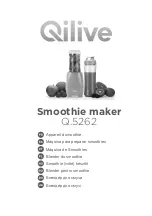
DRYING MEDICINAL PLANTS
* It is recommended to dry new leaves or stem cuttings.
* After drying it is better to put medicinal plants in paper bags or glass jars and store in a
dark dry place.
DRYING MEATS AND FISH
* Fresh or frozen lean meat makes the best jerky. The lower the fat content the better.
Meats with high fat content like lamb and cured meats will have a shorter shelf life.
Pork must be well cooked before drying. Only use pre-cooked and processed ham.
* Take extra precautions when preparing meat for drying as is it more susceptible to
bacteria than fresh produce.
* Wash hands, surfaces, utensils, chopping boards, crockery before and after handling.
* Slice meat across the grain to increase tenderness.
PRE-TREATING
To best maintain the colour, flavour, and vitamins of the food when drying, it may be
necessary to pre-treat before adding to the dehydrator. Please note that pre-treating is not a
necessity of using the dehydrator. Experiment with pre-treated and non-pre-treated foods to
see what works best for you. Pre-treating the foods varies on its type:
Fruit:
Naturally acidic solutions like pineapple or lemon juice can be used to reduce browning
of soft fruits like apples, peaches, apricots, and pears that occurs due to oxidation when
their flesh is exposed to the air. Simply slice the fruit directly into the juice for around 2
minutes before placing on the dehydrator trays. Dry them before adding to the appliance.
- TIP: Why not experiment with different juices, spices, honey, coconut or other
flavours to create your own personalised dip
Some fruit like figs, grapes, prunes, blueberries, and cranberries have a naturally protective
wax coating that will cause them to dry out very slowly and thereby lose a lot
of their natural nutrition. For these fruit, it is necessary to dip them into boiling water
for 1-2 minutes before placing in the dehydrator, dry them before adding to the appliance.
This will make the skin more porous, speeding up the drying time and retaining more
vitamins.
Vegetables:
It is better to boil vegetables for about 1-5 minutes and then put them in some cold water
and dry them before adding to the appliance. This is to destroy enzymes which produce bad
flavours during the dehydration process.
- Steam blanching is the preferred method if available. Steam the sliced pieces
for 2-3 minutes until heated through, but not cooked enough to eat.
- Microwave blanching in a covered microwavable container with a small
amount of water - refer to your oven’s cooking chart for cooking times.
- Boiled blanching for 3-5 minutes can be used if the above two are not
available.
Ensure that the slices are transferred to the dehydrator trays as quickly as possible after
blanching.
Summary of Contents for Healthy Choice FD1211D
Page 9: ......




























